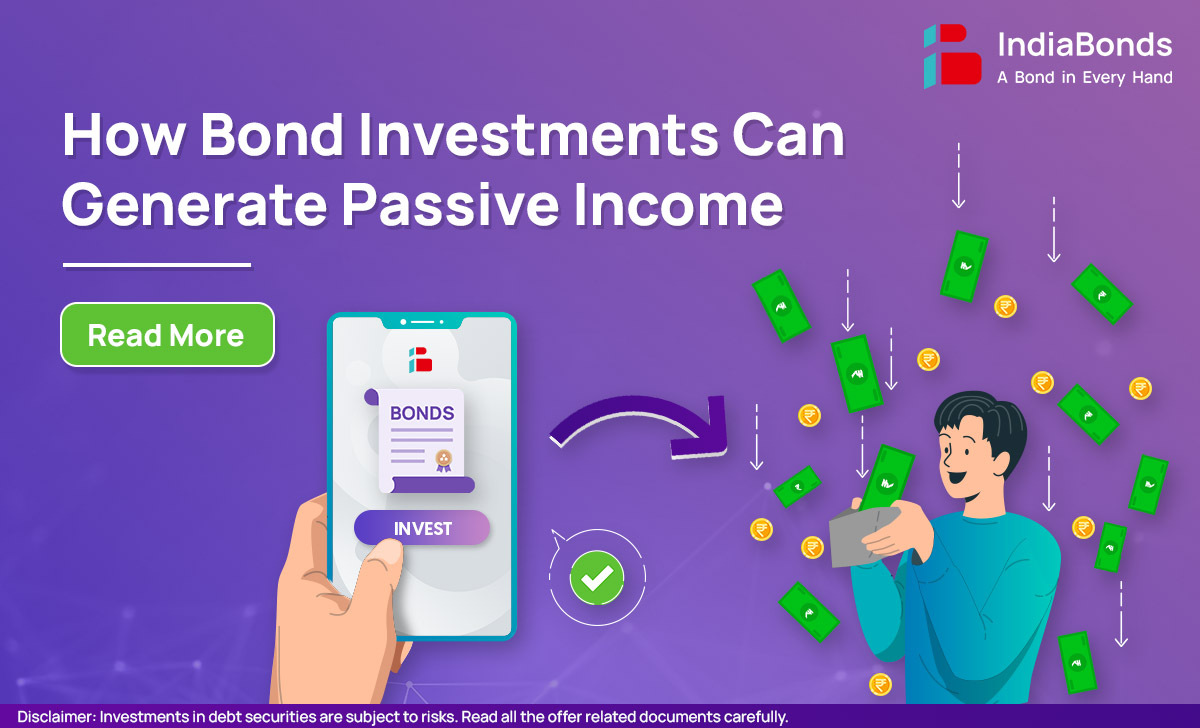How Bond Investments Can Generate Passive Income

“The big money is not in the buying or selling, but in the waiting.”
–Charlie Munger–
In this era of instant gratification and easy money, this quote emphasizes the importance of humility and patience in both life and investing, coming from one of the key figures behind the remarkable success of Berkshire Hathaway. Whether dealing with debt, equity or any other asset class, certain principles hold significant influence and this quote exemplifies one of them within the investment fraternity. IndiaBonds pays homage to the legendary investor Charlie Munger, may he rest in peace.
Introduction
In one of the previous articles, we explored the concept of passive income ideas and understood why bonds can serve as the ideal asset class for passive income. Now, let’s delve deeper into how bonds emerge as the penultimate instrument for generating passive income.
For those unfamiliar, bonds are fixed-income securities that essentially function as loans. So, when you encounter statements like “ONGC issues bonds worth Rs 1,000 Crores,” it simply means that ONGC is seeking to borrow Rs 1,000 Crores through a public issue of bonds. In simple terms, bonds serve as a means of raising funds which can be used for research and development or expansion activities. When a company issues bonds for a specific period, it commits to paying interest on the borrowed amount, known as a coupon. This interest is fixed and distributed annually or semi-annually, depending on the issuer’s terms and conditions. The borrowed amount or principal is then returned to the investor at maturity or at the end of the specified period. Quite straightforward, isn’t it!
Passive income refers to earnings that require minimal or no effort or time to maintain. Unlike active income, which is generated through direct participation in a job or business, passive income flows in with little to no ongoing effort. Common sources of passive income include: Rental income, investments, royalties, etc. By connecting the dots, one can recognize why bonds represent the epitome of passive income. Let’s elaborate this further by exploring the following three scenarios:
Scenario 1
Shreya, a 31-year-old chartered accountant by profession and a doting mother of two, found herself standing at the crossroads of her life. Faced with two options, she could either continue her 11-year illustrious career with her firm and progress towards becoming a partner or she could pursue her lifelong dream of starting her own café—a dream she had harbored since she could remember. Despite having a solid backing for her entrepreneurial venture, Shreya hesitated to take the plunge, considering the significant step it represented in her current situation. To bolster her financial confidence, she decided to invest in a high-yield bond from an emerging Micro Finance Institution (MFI), offering an 11% p.a. return. The fixed, stable and recurring interest component served as a substantial passive source of income, providing Shreya with the much-needed confidence to pursue her entrepreneurial dreams without constant worry.
Scenario 2
Oscar, a 45-year-old data scientist working at a startup in Bangalore, was also a personal finance enthusiast who had built a well-diversified portfolio over time. Everything was going fine. However, as they say, adversity strikes when you least expect it. The startup he worked for had to shut shop due to recession. Although a bit disappointed, it didn’t deter his confidence. He acted swiftly. Out of the saved corpus he had built over time, he mobilized a substantial amount into AAA-rated PSU bond with an 8% p.a. return. The best part was that this was a AAA-rated bond coupled with an inflation-adjusted rate. Since it was a PSU bond, it was backed by government safety. This strategy helped Oscar earn a source of passive income through coupon payments, covering his expenses for a while until he found another employment opportunity in such uncertain period.
Scenario 3
Subhash, a 55-year-old army veteran nearing his retirement, found himself in a predicament when he sat down with his daughter to address his post-retirement finances. He discovered that his monthly pension wouldn’t suffice to maintain his lifestyle in the future. Following his daughter’s advice, Subhash decided to invest a portion of his savings and retirement benefits in Indian Government Securities, more commonly known as G-Secs. The notable aspect was that, given the economy was at the peak of the interest rate cycle, Subhash earned a decent yield of more than 7%. Furthermore, deploying his retirement benefits in G-Secs, which inherently have a sovereign guarantee, provided Subhash with a worry-free investment. Unlike Fixed Deposits (FDs), there were no penalties for premature withdrawal. The combination of fixed interest payments and his monthly pension allowed Subhash to thoroughly enjoy his retired life.




Conclusion
In this exploration of how bond investments create passive income, we’ve uncovered the significant role bonds play in providing a stable and recurring income stream. In India, 62% of Gen Z individuals and 51% of Indian millennials engage in side jobs or have passive income, as reported by the Deloitte Global 2022 Gen Z and Millennial Survey. Bonds, as fixed-income securities, serve not only as a means for companies to raise funds but also as a reliable avenue for individuals seeking passive income. The fixed interest payments, coupled with the return of principal at maturity, make bonds a compelling choice for those looking to diversify their income sources and achieve financial goals. By examining real-life scenarios, we’ve seen how individuals like Shreya, Oscar and Subhash strategically used bond investments to navigate life’s uncertainties, whether pursuing entrepreneurial dreams, overcoming unexpected job losses, or securing a worry-free retirement. Bonds, with their stability and predictable returns, emerge as a cornerstone in the realm of passive income investments. In essence, the journey into the waters of bond investments for passive income has revealed a depth of financial opportunities, providing a foundation for financial stability and empowerment.
FAQs
Q. How bond investments can generate passive income?
A. Passive income with bonds is achieved through fixed coupon payments. When you invest in bonds, the issuer commits to paying you regular interest, known as a coupon, over a specified period. This predictable income stream serves as a stable and passive source of earnings, allowing investors to generate consistent returns without active involvement. The fixed nature of coupon payments provides financial stability, making bonds an attractive option for those seeking reliable passive income.
Q. Does bonds give monthly income?
A. The frequency of bond payouts varies; some bonds provide monthly payments, while others offer quarterly, semi-annual, or annual disbursements. Ultimately, the payout schedule depends on the conditions set by the bond issuer.
Q. Can anyone invest in bonds for passive income, or is it limited to specific demographics?
A. Bonds are accessible to a wide range of investors, from individuals seeking to diversify their income sources to seasoned professionals navigating various life stages. The versatility of bond investments makes them suitable for a broad demographic looking to build a resilient and diversified financial portfolio.
Q. How do interest rates and credit ratings impact the returns from bond investments?
A. Interest rates and credit ratings significantly influence bond returns. Higher interest rates generally result in higher yields, while credit ratings indicate the issuer’s creditworthiness. Investors should consider these factors when choosing bonds to align with their financial goals and risk tolerance.
Disclaimer: Investments in debt securities/ municipal debt securities/ securitised debt instruments are subject to risks including delay and/ or default in payment. Read all the offer related documents carefully.



















































